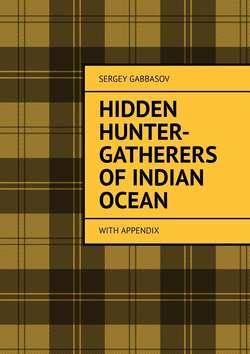Hidden Hunter-Gatherers of Indian Ocean. with appendix

Реклама. ООО «ЛитРес», ИНН: 7719571260.
Оглавление
Sergey Marlenovich Gabbasov. Hidden Hunter-Gatherers of Indian Ocean. with appendix
FOREWORD
SPIRITS OF THE YELLOW LEAVES
MONKEYS, SNAKES AND FOREST BEINGS
VEDDAHS
COASTAL VEDDAHS
AHIKUNTIKA
PEOPLE OF THE FOREST
ON THE STONE TOP
TENRECS AND ZEBU
CONCLUSION
REFERENCES
APPENDIX
Banyan Leaves – The Route From Maharajas to Pharaohs
INTRODUCTION
IN THE LAND OF RAJAS (GYPSY-LIKE GROUPS OF RAJASTHAN)
BY THE RIVER OF JORDAN
IN THE LAND OF THE PHARAOHS
CONCLUSION
REFERENCES
Irish Travellers and Stick Fighting
REFERENCES
Отрывок из книги
Whom we imagine when talk about hunter-gatherer? A dark-skin small man almost without any clothes, with a spear or bow and arrows. His family live in a deep rainforest or in an endless savannah, they make a fire by drilling, live a nomadic life and know nothing about agriculture and pastoralism. It is enough for a standard person who is ready to forget everything that doesn’t concern with his everyday job. But if you read this book – you are not such a person.
We also know that their lifestyle is the most ancient and 90% of all human beings who ever lived on our beautiful planet (~80 000 000 000 individuals) were hunter-gatherers (Lee & DeVore 1968). It is the most effective, most harmonized and ecological way of connection between humans as biological specie and all the nature itself. Living as a hunter and gatherer, human don’t opposite themselves to the nature by a constant fighting in a constant process of production food by keeping cattle (making pastures, killing predators, overgrazing) or agriculture (slash-and-burn cultivation, deforestation, invasion of plants). Every anthropologist who is interested in hunter-gatherers knows such iconic peoples as Hadza of Tanzania, Baka of South-East Cameroon and Mbuti of North-East DRC, Bushmen of South Africa and Kubu of Sumatra, about Andamanese and Indigenous Australians.
.....
Music and dances were very important in the traditional life of the Mlabri. Music is a part of recreational and ritual activities of human society. For Mlabri music is a relaxation when they success in hunting or have a celebration, a festival, for spirit sacrifice or burial ceremony. The only one musical instrument they have is a khaen, and a type of songs accompanied by a khaen is named “molum Mlabri” (Paiyaphrohm 1990).
Khaen is a type of musical instrument (mouth organ), commonly found in Northeast Thailand. It is made of bamboo tubes, hollow wood and beewax. No Mlabri musicians make it, that may indicate that Mlabri obtain it from outsiders or they had already forgotten how to make it. Moreover, it is remarkable that Mlabri can’t play Hmong khaen even though they have been in contact with them for a long time. Besides Hmong believe that khaen is a high-class musical instrument, they aren’t allowed to play it without some ceremony except for themselves, so Mlabri have no occasion to play on it.
.....